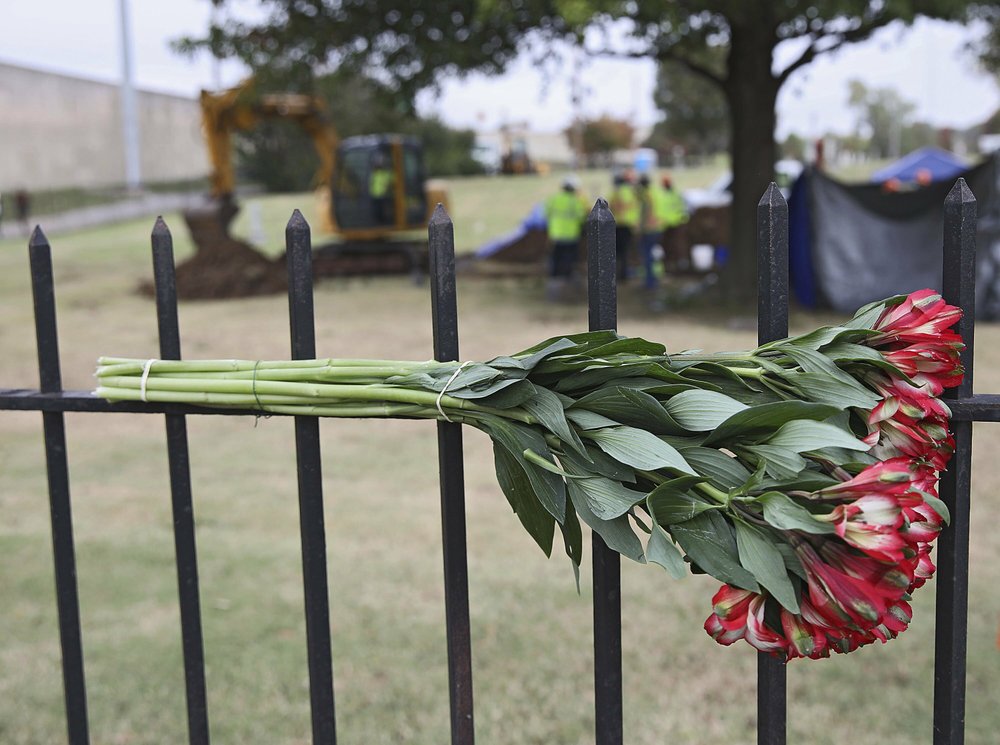Researchers seek new search for Tulsa Massacre victims
A report recommends additional excavation of Oaklawn Cemetery and additional scanning for possible mass graves in a park and adjacent homeless camp.
The discovery of human remains that could possibly be victims of the 1921 Tulsa Race Massacre in Oklahoma shows that the search for mass graves should continue, researchers said.
A report submitted to Tulsa’s committee overseeing the search said one body, believed to be a Black male in his mid-to-late 20s, is a possible massacre victim and had three gunshot wounds with two bullets recovered from the remains, including one from the head.
Forensic anthropologist Phoebe Stubblefield said Wednesday that DNA could provide circumstantial evidence linking the remains to the massacre. But she said that it likely can never be confirmed with certainty that any remains were massacre victims.
Flowers left by a mourner hang on a fence as crews work on a second test excavation and core sampling in the search for remains at Oaklawn Cemetery from the 1921 Tulsa Race Massacre Wednesday, Oct. 21, 2020. (Mike Simons/Tulsa World via AP)
The man was shot, Stubblefield said, but when and the circumstances of the shooting will never be known.
“The person had a death that involved another human, so that part is clear, but when that death occurred, there are no definitive indicators and the exact context of … how did the bullets get introduced, there’s no indications under the earth for that,” Stubblefield said.
The .38-caliber bullets are believed to be from a Colt revolver, but could not be linked to the same gun because of their deteriorated condition, the more than 1,000-page report stated.
Another six bodies could not be excluded as victims, according to the report presented by Stubblefield and state archaeologist Kary Stackelbeck.
The bodies were exhumed in 2021 after 35 coffins were found during the excavation with 20 sent for further examination.
One of the 20 coffins, believed to be an infant, contained no remains.
In this photo provided by the Department of Special Collections, McFarlin Library, The University of Tulsa, a group of Black men are marched past the corner of 2nd and Main Streets in Tulsa, Okla., under armed guard during the Tulsa Race Massacre on June 1, 1921. (Department of Special Collections, McFarlin Library, The University of Tulsa via AP, File)
The report recommends additional excavation of Oaklawn Cemetery and additional scanning for possible mass graves in a park and adjacent homeless camp, where oral histories have indicated massacre victims were buried.
Tulsa Mayor G.T. Bynum said the city will work to implement the recommendations.
“The City of Tulsa will need to solicit bids for the work to be done in order to determine the necessary budget for the next stage of this investigation,” Bynum said in a statement.
The 1921 massacre occurred when a white mob descended on the Black section of Tulsa — Greenwood — and burned more than 1,000 homes, looted hundreds of others and destroyed its thriving business district. Most historians who have studied the event estimate the death toll to be between 75 and 300.
TheGrio is FREE on your TV via Apple TV, Amazon Fire, Roku and Android TV. Also, please download theGrio mobile apps today!
The post Researchers seek new search for Tulsa Massacre victims appeared first on TheGrio.

